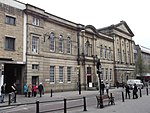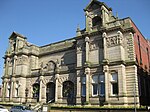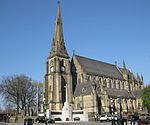|
Holy Trinity Church, Bury
Holy Trinity Church is in Spring Street, Bury, Greater Manchester, England. It is a redundant Anglican parish church in the diocese of Manchester.[1] The church is recorded in the National Heritage List for England as a designated Grade II listed building.[2] HistoryThe church was built between 1863 and 1865 at a cost of about £5,500 (equivalent to £660,000 in 2023).[3] It was designed by the Lancaster architect E. G. Paley. The original plan included a south aisle and a north tower with a spire, but these were never built. The site was given by the 14th Earl of Derby, who also donated £1,000. As built, the church provided seating for 627 people.[4] The church was extended in about 1920.[2] Edward Hordern, the father of the British actor Michael Hordern, was a rector at the church, likely around the turn of the 20th century.[5] On 30 November 2010 the church was declared redundant,[6] and its parish was merged with those of St Peter, Bury, and St Thomas, Bury, forming the new parish of Roch Valley.[1] As of 2011, it was planned to sell it for use as a children's nursery and an early learning centre. ArchitectureHoly Trinity Church is constructed in coursed rock-faced sandstone with ashlar dressings. It has Welsh slate roofs. The architectural style is Early English. Its plan consists of a nave, a north aisle with a porch, a chancel with a Lady chapel and a vestry to the north.[2] As the arcade runs down the centre of the church,[2] it is described in the Buildings of England series as a "double-naved church", with "the chancel attached to the south nave".[7] The windows at the east and west ends contain "heavy plate tracery".[7] The arcade has five bays and is carried on round piers.[7] Between the aisle and the Lady chapel is a three-bay arcade.[2] In the Lady chapel is a brightly painted reredos, added in 1987 as a First World War memorial.[7] See also
References
|
||||||||||||||||||||||||||||||||||||||||||||||||||||||||||




